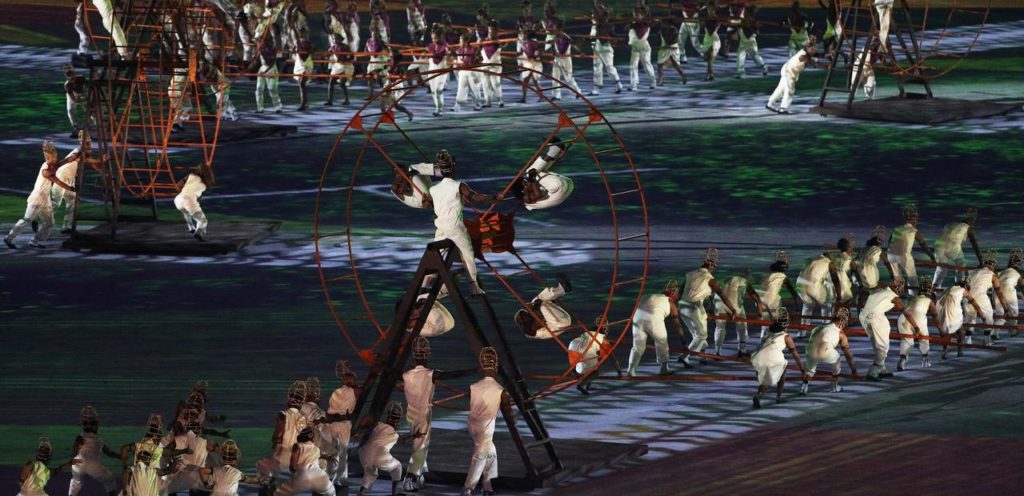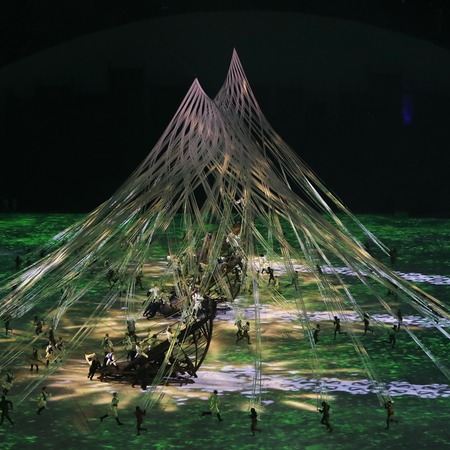11/9/16 -The History of the Olympics…or the Olympics as History, Part II
November 9, 2016Fanfare, Glory, Spectacle: The opening ceremonies of the Olympic Games invite spectators to lose themselves in a state of suspended disbelief, even if for the briefest of moments. The combination of music, lights, and the palpable excitement at the most recent Rio Olympics filled the arena as the event commenced. This opening event and the hyped-up presentation of the host country’s history is not an original element of the Olympic Games, and its beginnings were fraught with controversy. This blog traces how the opening ceremonies have evolved over the past 100 years.

Displayed above is a photograph of the 1896 Athens opening ceremonies superimposed over a photographs of more recent opening ceremonies. Photo credit: Mashable.
The first blog in this series, available here, describes the history of the modern Olympics. The concept of a grand opening display that offers an opportunity for visually exciting patriotic celebration while showcasing symbolic elements of the Games has developed over time. The 1936 Olympic Torch Relay displayed an early example of opening ceremony spectacle in Berlin. The International Olympic Committee nominated Germany to host these games as an effort to signal “Germany’s return to the world community after defeat in World War I.”[1] Adolf Hitler conceived of the relay amidst global concern over his country’s discrimination and persecution of Jewish-German athletes. However, the pageantry of carrying a torch from Olympia, Greece to Berlin, Germany only perpetuated Nazi propaganda and the “racial myth that superior German civilization was the rightful heir of an ‘Aryan’ culture of classical antiquity.”[2] Yet, despite the relay’s nationalistic and racist beginnings, it has morphed into an expected ritual of the modern Olympics that recognizes exceptional athletes and historically relevant world citizens, while contributing to the display of the opening and closing ceremonies.

On August 1, 1936, Hitler opened the 11th Summer Olympic Games. Pictured above is an Olympic torch bearer running through Berlin, passing by the Brandenburg Gate, shortly before the opening ceremony. Berlin, Germany, July-August 1936. Photo credit: National Archives and Records Administration.
As the symbols of the modern Olympics emerged, so too did the tradition of an “opening ceremony.” Since the first official opening ceremony at the Antwerp Games in 1920,[3] the demonstrations have become more elaborate and more expensive, as host countries attempt to outperform their predecessors.

The 2016 Rio Olympic opening ceremonies referenced the country’s history of slavery. Photo credit.
However, in the most recent Rio Olympics, the organizing committee faced budget challenges as well as infrastructure challenges. Not only were the doors into the main stadium too small to bring in large equipment to be used in the ceremony, but Brazil’s severe economic recession created financial challenges for the organizers of the event.[4] Despite these challenges, the committee managed to choreograph a visual display of Brazilian history using an advanced light projector. But the opening ceremony conveyed a romanticized history, especially when viewed with the American news commentary.

During the opening ceremonies, many viewers turned to twitter to comment on the spectacle and Brazil’s decision to incorporate the country’s history of slavery as part of the display. Photo credit.
The visuals, choreography, and story of the Rio opening ceremonies indicated that Brazil acknowledged the significantly negative environmental and social consequences of the county’s past, such as mass deforestation. However, NBC commentators made the mistake of calling the Portuguese colonizers “immigrants” instead of recognizing Brazil’s attempt to highlight its history from the indigenous people’s viewpoint, one that saw the Portuguese as colonizers. Thus, the American media’s lens conveyed “the gap between the colonized worldview and that of the colonizers.”[5] This commentary constituted a prime example of revisionism that muddled the history that Brazil was trying to acknowledge. The American media thwarted organizers’ attempts to factually portray a version of Brazilian history that recognized the realities of slavery and colonialism from both social and environmental perspectives.[6]

The 1976 Montreal Summer Olympics included hundreds of native and non-native dancers dressed in appropriated Native dress as part of the closing ceremonies. Photo credit.
Other countries have also struggled to display their heritage during the ceremonies in a way that recognized the past without cultural appropriation or misrepresentation. On more than one occasion, Canada struggled to respectfully represent the culture and history of its native population during the Olympics. During the 1976 Montreal games, organizers planned to include Native dancers in the closing ceremonies, marking the first time that a country included native North American people in an Olympic ceremony since 1904, when their inclusion was only meant to reinforce the stereotype of the “savage” Indian.[7] Despite the passage of 70 years, organizers were more focused on the theatrics of the display than on the true representation of Canada’s First Nations. As such, the plans included using mass manufactured, color-coordinated “native attire” as opposed to true regalia, as well as 250 non-native dancers participating alongside representatives of Canada’s First Nations.[8] While many of the Native participants recognized their participation as misrepresentative of their true native cultures, they also understood that by participating on the world stage they were exercising their agency and advocating for their own political rights.[9]
![Athletes and members of Sweden's delegation attend the opening ceremony for the Vancouver Winter Olympics at BC place in Vancouver on February 12, 2010. The Games' build-up culminates with the lighting of the Olympic cauldron at BC Place in Vancouver, a ceremony held indoors for the first time in the competition's history. AFP PHOTO / DAVID HECKER (Photo credit should read DAVID HECKER/AFP/Getty Images) [PNG Merlin Archive]](https://www.shraboise.com/wp-content/uploads/2016/11/first-nations-Vancouver.jpg)
The Vancouver Opening Ceremonies featured representatives from Canada’s First Nations in a more truthful display of native culture and heritage. Photo credit.
The Olympics are a major disrupter for any city or region that hosts them, and the opening and closing ceremonies have become a vital component of experiencing this worldwide event. Given the anticipation, excitement, and jubilation that accompany the games, one has to wonder, what becomes of the built environment that played host to thousands of athletes and spectators once the medals have been awarded and excitement has died down? In short, after the world leaves, what happens to the empty stadiums and the ghost-like Olympic Village? For answers to these questions, check back soon for the final installment in this blog series where I will explore the environmental history of the Olympics.
– HannaLore Hein
______________________________________________________________________________
[1] “THE NAZI OLYMPICS BERLIN 1936: INAUGURATION OF THE OLYMPIC TORCH RELAY,” www.ushmm.org
[2] Ibid.
[3] “The Ceremonies of the Olympic Games,” olympics.mu
[4] “After A Rough Run-Up, Rio Aims For An ‘Awesome’ Opening Ceremony,” August 5, 2016. npr.org
[5] Noor Al-Sibai, “The Opening Ceremony Addresses Slavery & Colonialism, And It’s Something The US Could Learn From,” bustle.com
[6] Ibid.
[7] Evan Andres, “8 Unusual Facts About the 1904 St. Louis Olympics,” August 29, 2014. www.history.com
[8] Jessica Deer, “Blast From The Past: Onkwehón:we At The Olympics In Montreal 40 Years Ago,” The Eastern Door, August 1, 2016.
[9] Ibid.